| |
Email is one of those things that, until recently, people didn't know they needed. Although email is seen as a communication time saver, in other ways it is a time eater. There are even cases in which people would be better off if they didn't have email at all. In order to avert such scenarios, there are some email practices that need to become standards.
Here are a few basic tips that will allow you and anyone you email to enjoy the benefits of this form of communication while avoiding some of the most common pitfalls.
1. Use a clear and specific subject line.
Using terms like "Hey" and "Hello" in the subject line tells the recipient absolutely nothing about the content of the email. If someone saves your messages and all of the subjects are "hey" and "hello", they will have a difficult time locating a specific message.
Here's a peak into one of my folders entitled "friends". I do love my friends, but I have no idea what any of them are talking about based on any of these subject lines.
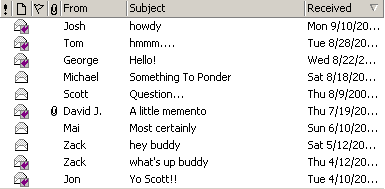
Here is a list of vague terms that should be avoided:
- Hello
- Hey
- How are you?
- Check this out!
- Hmmm...
- Question
- Yes
- No
- Yo
- A few thoughts
- Thought of you
Sum up the email very clearly. If it has to be a little long to avoid confusion, then so be it. For example, you and a friend have previously discussed IBM computers versus Dell computers and you have finally decided that IBM is better. The title of your email explaining how you arrived at your conclusion could be "IBM vs. Dell --> IBM is better." This sums up your message clearly and allows the recipient to differentiate it from the other messages in their inbox.
Here's a look into my sent items. I try to follow my own rules of clearly naming emails, but no one's perfect. Each has a distinct name and I can scan through these emails quickly to find what I am looking for. The first email entitled "Sending me large files" is descriptive, but could have been clearer. Naming it "Instructions for sending me large files" would have been more specific.
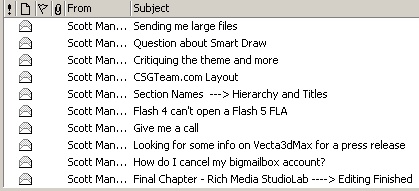
Yet another example of a subject line gone bad: I was in the Czech Republic on September 11, 2001 when I caught wind of a terrorist attacks against the USA. I only had time to check important emails, so I scanned the subject lines. This one from my mom entitled "Hello Son" looked very unimportant, but as you can see, it was quite the opposite. I did not check this email for another four days. Lesson learned: do not email people about death and mass destruction using the subject line "Hello". (I love you, Mom).
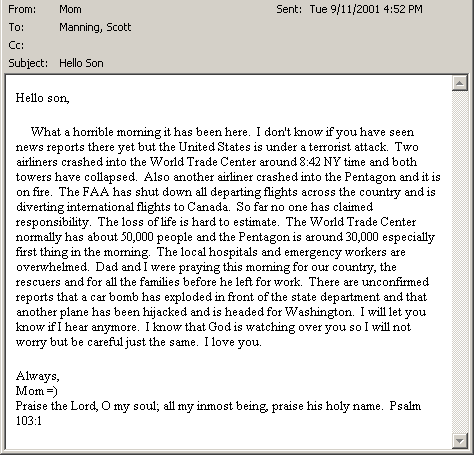
2. When sending an attachment, include the title of the document in the subject line.
For example, If I am sending an image of my wife and I, then the title of the email will be "Picture of me and my wife". Simple.
3. When sending a series of emails with attachments, number the emails in the subject line.
Let's say you are sending a series of images of you at work. Simply title your emails, "Pictures of me at work: #1-3", Pictures of me at work: #4-5", etc.
Do not call all of the emails in the series by the same name. For example, if you send five emails with pictures of you at work and all of them are entitled "Pictures of me at work" , this will lead to confusion and hassle. It will be easy for the recipient to lose track of which emails they have viewed, and it will make it very hard to refer back to a particular picture after all the emails have been opened. Also, the recipient may assume it was a duplication error and delete the last four messages without opening the pictures to see if they are the same or not.
In this screenshot, each one of these emails has a different picture. If I want to locate a particular image, I have to go through each email and open the picture before I can find the one I want.
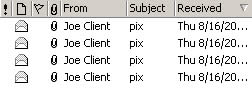
4. When replying to an email, ALWAYS include the previous message you are replying to.
Many people reply to an email and only include their responding message. With so many emails flowing to and from our computers it is easy for the person on the other end to forget or to recall incorrectly what it is that you are referring to.
Even with a clearly defined title, I'm not sure what Rich is talking about here. I now have to go find the email from my sent items to find out what he is talking about.
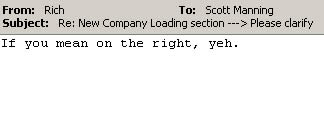
This gets even more complicated when someone has saved everything you've emailed and then needs to go back in search of something you said two weeks ago. If all of the emails from you include text like "Yes", "Whatever you think is best", "Let me get back to you", etc. they will have a hard time recalling what you were talking about. You may have given them some definite answers, but there is no easy way they can refer back to them.Also, neglecting to include previous text may be considered "shady" to some. If someone doesn't follow through with what they've agreed to do via email, you will have no legitimate way of holding them accountable with an email that just says, "I'm in". The message needs to specify what they are "in" for, and including the previous email is a straightforward solution.
5. When replying back and forth on the same email chain, change the subject line.
It happens all the time: Someone sends us an email asking a question and we hit the reply back button without changing the subject line. This isn't so bad until they respond back asking for more clarification, again without changing the subject line. You reply back a second time with the clarification under the same title. That person responds again to say thanks and then asks you how your week has been. You reply back with "fine, and yours?" And in a matter of minutes you have a dozen emails with the subject line "Re: Question concerning power supply in laboratory", over half of which have nothing to do with that subject. Changing the subject line each time to match your response will keep your communications organized and prevents your inbox from getting that glazed-over look.
Joe and I went back and forth using the same subject line for several days. How can we find a particular comment the other made in these emails? That's right - by going through each email one at a time. Zzzz zzz zzz zzz.
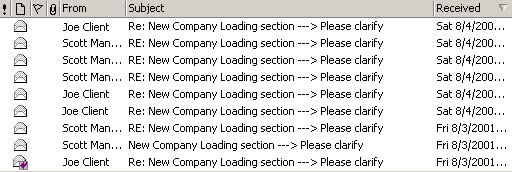
Well, there you have it. Using these standards will save you and the people you email time and energy. With your inbox under control, you'll have time for the finer things in life, like reliving your childhood through Ebay.
Related links:
E-mail abuses cost UK firms millions
Added 8/10/2005: The key to email: a two-second grab
Added 10/13/2005: 12 tips for better e-mail etiquette
Added 10/13/2005: Writing sensible email messages |
|
